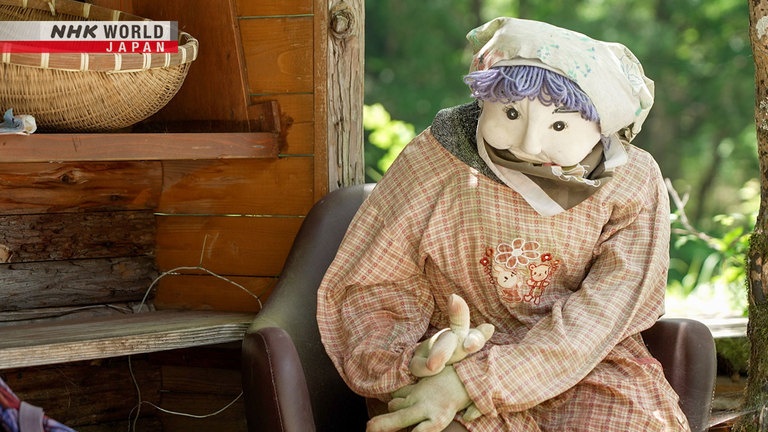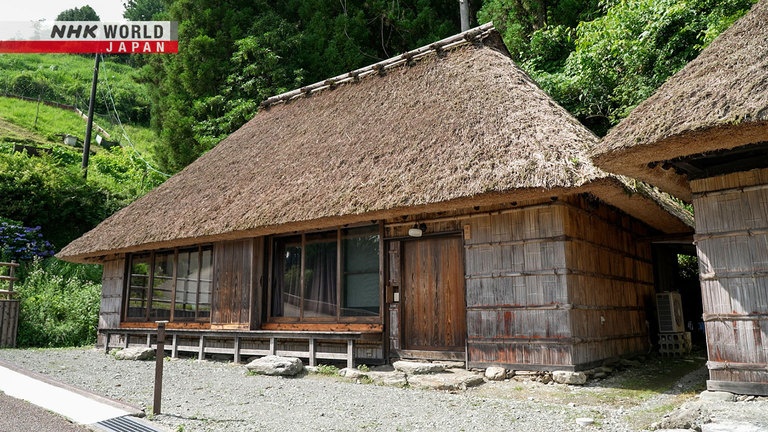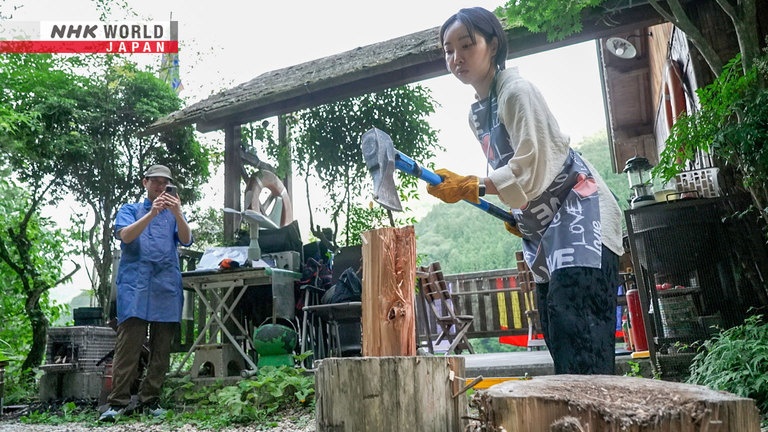Discovering the Wonders of Iya Valley
Deep in the mountains of Shikoku lies Iya, which is home to a few small settlements. The steep, narrow and misty valley is the stuff of lore. In the 12th century it was a haven for fugitive Heike clan warriors who easily slipped away in the rugged terrain. Over the years, the community has seen its population shrink and age. But a decade ago, Iya became a popular destination for overseas visitors. We visit Iya to find out why and search for hints for regional revitalization.
Scarecrow Village

The life-like kakashi scarecrows in Nagoro are what sparked the boom in overseas tourism. Over 350 of the figures, which are often mistaken for villagers, are found across the area.
Ochiai Village

Ochiai features traditional architecture with restored thatched roofs. It was registered as a conservation area for historically important buildings in 2005. Some of the 300-year-old residences have been converted into elegant inns. Locals offer tours and workshops.
Okuiya District Guest House

This is the place for people who want to immerse themselves in an old, rural way of life. Try your hand at wood-chopping and steaming rice in a kamado fueled by kindling fire.
Access

Fly from Tokyo's Haneda Airport to Tokushima Awaodori Airport. It takes about 2 hours by bus and train to reach JR Oboke Station. From the station, the settlements are accessible via bus or taxi.
Transcript
Hidden deep in the mountains of Tokushima
is a place called Iya.
The steep, narrow valley, often shrouded in mist,
is the stuff of lore.
In the 12th century,
it was a haven for fugitive Heike clan warriors
who easily slipped away in the rugged terrain.
About ten years ago, a curious thing...
overseas visitors became enchanted with this mysterious setting.
The area is nice, so I would like to come back here again.
Not necessarily because of the bridge, but it's nice here.
I like the nature, I like the color of the water.
I don't know why it's so green.
The river is nice.
And there's lots of animals and all that stuff.
But beyond the stunning nature, there is something else.
These beguiling figures, over 350,
that populate a small village.
These figures have enlivened the community
and connected me to many people.
Violet Pacileo is a rural revitalization consultant
based in neighboring Kochi Prefecture.
Hi, this is Violet. I live here in Otoyo, in Kochi Prefecture.
And across that mountain there is Iya Valley
in the neighboring Tokushima Prefecture.
This river here is the famous Yoshino River that connects us there.
I heard that there's a small village in Iya Valley
that's attracting a lot of foreign tourists.
I want to find out why the tourists are flocking there, and not here,
and find clues I can bring back.
Violet is about to step into a magical realm on "Journeys in Japan."
Discovering the Wonders of Iya Valley
Iya is 700 kilometers west of Tokyo in Shikoku.
Around 2,300 people call it home.
Surrounded by the peaks of the Shikoku Mountains,
the area had long been inaccessible.
Even now, the connection to the outside world is via a steep, winding road.
Yet, it draws in thousands of overseas tourists.
I've just traveled about ten minutes down the Yoshino River,
and now, I'm in Iya Valley.
Scarecrows are apparently the tourists' attraction here.
I'm wondering how scarecrows can be such a tourist attraction.
Let's go and find out why.
Violet heads to the most inland settlement of Nagoro, population, 25.
Starting to see a few scarecrows in places.
Whether they're people or scarecrows, I'm not sure yet.
Wow, look at these over here.
You've got scarecrows, I'm assuming,
doing farm work, digging up potatoes.
You've got scarecrows everywhere.
Look at these scarecrows.
They've even got a mask on.
Holding a stick.
I'm meeting the creator of these scarecrows today.
Let's go and see if she's here.
Hello. You must be Ayano-san.
I am.
I'm Violet. Nice to meet you. I hope to hear about your work.
- Did you make all of these?
- Yes.
Amazing. One with earrings.
There are all kinds.
About 20 years ago,
Ayano Tsukimi began creating them in memory of fellow villagers
or from her imagination.
Overseas visitors started coming to see the works in 2014
after a German student's short documentary went viral,
catapulting Iya's scarecrows into the world's spotlight.
This is just unbelievable.
That's my grandson. Down to his skateboard and hair.
- That's his hairstyle.
- Right.
- And the clothing?
- Yes.
There's one down there fishing.
Really?
I thought it was a person.
I never imagined something I was doing for fun
could turn into such a big thing.
It's amazing.
People from around the world are coming to see your work.
The city offered Ayano a vacant nursery school to use as a studio
after so many visitors kept showing up.
- There are so many.
- Yes.
I like the way she is reposing.
- She is quite popular.
- Everyone likes this granny.
Many take pictures with her.
Can you guess what the stuffing is?
Cotton? Straw?
- Newspaper.
- Really?
Join me to see how it's done.
Roll it up, hold it in the middle and twist.
- All the way to the top?
- That's right.
Go back to the middle and twist the other half.
Like wringing out a cloth.
This is what you get.
Eighty of these go into their bodies.
That's a lot.
- It's a lot of work.
- I bet.
At a closed elementary school...
Unbelievable. They look human.
Some are.
- Really? That's scary.
- It's hard to tell.
Everybody says so.
Ayano has reenacted a sports meet held during the settlement's heyday.
This self-study was made by someone from the US. Joe.
So it says.
Then he made his father in the following year,
and his mother in the third year.
He came back every year?
He kept coming back for about four years.
People visit here from all over the world. How does that feel?
It makes me happy.
If it were not for the scarecrows, no one would have come.
They enlivened the village and connected me to many people.
I'm glad that I've been making them.
I can see that.
Vine bridges across gorges were
crucial to villagers' travel in days gone by.
Three are still maintained by the city.
Hello, nice to see you. I'm Violet.
Welcome to our hotel.
Ueta Yoshihiro runs this lodging and heads the local hotel association.
Since 2014, he's traveled to the US, Europe,
and Southeast Asia to promote Iya's appeal.
When I visited tourist destinations in the US for work for the first time,
I hit upon the importance of promoting unique, local culture.
We can offer things that are found in our mountainous village,
like buckwheat noodles or freshwater fish.
Locals take them for granted and think little about them.
But the truth is,
it's often not something special that fascinates foreigners,
but rather the everyday meals, scenery,
and ways of living not seen elsewhere.
I've learned from my experiences in inbound tourism
that we can impress visitors from abroad...
when we show them what we have naturally, as they are.
We need to show off these simple charms.
Of course, we need to work on ways to showcase them, though.
Twenty thousand foreign tourists visited Iya in 2019.
Twenty-three times the figure of ten years earlier.
Once a blacksmith's workshop,
this property is now an inn that welcomes one party per night.
Shinomiya Yasuki runs it.
Originally from a nearby city,
he moved here, attracted by Iya's way of life.
You can't make a day trip here. You have to stay overnight.
You won't get to know Iya without having three meals here.
He is hosting a couple from South Korea.
Shoes okay.
Good job!
Do you like it?
I love it.
Have you done it before?
- No.
- First time.
First time? That's very good.
Is it tiring? Are you tired?
No, it's okay.
Steaming rice the time-honored way.
Tired...
The many overseas guests here enjoy these hands-on experiences
reflecting on an old way of life.
Good job, good job.
Whenever possible, locally sourced ingredients are used in the meals.
In regular inns, everything is done for guests.
So, they end up toying with their phones.
Here, though, I keep them busy with experiences and fun stuff.
The tiny Ochiai settlement is spread out over the mountain slopes.
It's designated as a preservation district for traditional buildings.
And eight thatched roof residences, around 300 years old,
have been converted into lodgings.
What a beautiful house. I feel like I've come back to the Edo Period.
Hello.
Hello.
- Are you Koda-san?
- Yes.
- I'm Violet. Pleased to see you.
- Likewise.
Koda Shota manages the farmhouse inns.
Come inside. I'll show you around.
Wow! It's very high. It's a vaulted ceiling.
We didn't install ceiling boards, so guests can see the thatch.
It makes the room look larger, too.
The home has no tatami mats,
usually a fixture of traditional architecture.
But it turns out wood was the historically used flooring material.
This is the biggest room in the house.
Very stylish. May I step down?
Sure.
This room offers the best view of the thatched roof.
Repairing the roofs was the biggest challenge
in the renovation of these buildings.
Each one required six to seven tons of thatch.
Are there roofers to repair them?
We had to bring in craftsmen from elsewhere
when we first repaired the roofs.
But locals learned the technique while working with them.
They now can do the repairs.
This project is not just about giving a new life to old homes.
It is also making your community sustainable and creating jobs for locals.
That's right.
We employ locals to clean the rooms and prepare meals.
Someone who lives two doors away
brings flower arrangements with her when she comes in to clean.
While staying here,
guests not only experience what it's like to live in old homes,
they also connect to the community and villagers.
Our place enables visitors to enjoy the scenery and nature.
We hope it will also benefit locals,
for example, by giving them jobs.
The surge in visitors from overseas
has been transforming residents' lives.
Minami Toshiharu was born and raised in Ochiai.
His tours are steeped in collective village memory and personal experience.
He is guiding Violet along a road locals used daily in olden days,
called the Akasujimichi.
This strengthens your lower body.
It feels like we are going back in time.
It does.
You used a path like this to go to school as a child?
Yes. I walked all the way.
That's the school I attended.
That's far.
Can you see the red roof?
Amazing. You walked even on rainy or snowy days.
There's something I want to show you.
A stone wall built in the 1700s.
It's that old?
It looks like the ones you see in castles.
Yes, it does. It's slanting.
The stone wall was built using a masonry technique called "sangizumi."
This method of alternately laying large and small stones
enhances wall strength.
Are these stones from the river?
They were unearthed when they cleared the land for farming.
They used the large ones for a house foundation,
and the small ones for the walls supporting the fields.
It's amazing that this stone wall has endured over 300 years.
It's a testament to our predecessors' wisdom.
- Shall we move on?
- After you.
This is called a "hade."
We use it for sun-drying our crops.
Such as onions.
And buckwheat.
- Maybe, garlic, too?
- And rice.
We pray to our local deity for family prosperity and good harvests.
Visitors can also enjoy rice cake pounding
and buckwheat noodle making workshops at the shrine.
Are you getting a good response?
Yes. We have more participants compared to when we started out.
I've been studying English
since I turned 70.
I've improved my vocabulary, which comes in handy during the tours.
Most customers at this souvenir store are tourists from abroad.
- Is that the stairway?
- Yes. Follow the red lines.
Tsai Yi Hsuan, who is originally from Taiwan, works here.
She came to Japan in 2016 as a student intern,
and began working at the shop.
How is life here different from a big city?
People are closer.
When I first came here, neighbors often came by to say hello.
They also brought food and asked about my job.
It was my first time being abroad, and their kindness put me at ease.
She fell in love with a colleague who is an Iya-native,
married and settled down.
She now lives in a neighboring town with her husband and their baby.
Hi, Mother. I'm back.
Hello.
- She ate a lot today.
- That's great.
- Is she your first grandchild?
- Yes.
She's so cute.
Yes. Our neighbors always want to speak to my daughter-in-law.
They also adore the baby.
Violet asks Tsai why foreigners are so attracted to Iya.
Iya is nowhere. That's why it attracts overseas visitors.
Cities all look the same everywhere in the world,
with many buildings, cars, and people.
But stunning nature differs from place to place.
Iya has nothing but nature
and that makes this spot so appealing to foreigners.
I learned a lot coming on this trip to Iya Valley.
The entrance is only about a 15-minute drive from my home.
The population here is about a third of my town,
so I wonder what they're doing differently.
It's not uncommon for mountain communities
to let their biases get in the way of decision making.
But here, multiple people went against the herd,
and became catalyst for change.
The community collectively came up with unique ideas,
leadership came and brought all those ideas together.
And this is something Otoyo can also learn from.
To reach Iya from Tokyo,
fly from Haneda Airport to Tokushima Awaodori Airport.
From there, it takes about two hours by bus and train
to JR's Oboke Station.
All settlements are accessible by bus or taxi from the station.